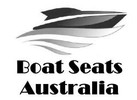Boat Seat Standards
The American Boat and Yacht Council (ABYC) has recommended marine industry seating standards for pedestal applications. These standards are used as a guide in Australia and by manufacturers around the world. Seat structure recommendations apply to permanently installed seats in cockpits, deck areas and all helm positions, including their fastenings and structures to which they are attached. It is a guide for the design, testing, construction and installation of boat seat systems.
The standards are referred to as H-31 and divide boat seating systems into two separate categories:
| Class "A" System | Seating systems (seat and pedestal) designed for occupancy while a vessel is underway at any boat speed. The CLASS "A" System is sub-divided into CLASS AD (Driver) and CLASS AP (Passenger) systems as follows: | |
| CLASS "AD" DRIVERS SYSTEM: Seat mounts must have a positive locking mechanism (i.e. a pin lock) which shall withstand a torque of 205Nm (150 foot pounds). Seat pedestals systems meeting this requirement are indicated with the symbol shown to the right on this web site. |
 |
|
| CLASS "AP" PASSENGER SYSTEM: Seat mounts shall withstand a torque of 41Nm (30 foot pounds). Products meeting this classification are known as "Non-Locking", and are indicated with the symbol shown to the right on this web site. |
 |
|
| CLASS "B" System | Seating systems (seat and pedestal) designed for occupancy only at boat speeds not exceeding 8km/h (5mph). Seat pedestals systems meeting this requirement are indicated with the symbol shown to the right on this web site. |
 |
NOTE - All seats are classified as CLASS A. A seat combined with a CLASS AD seat mount is therefore usable as an Operator/Driver/Helm system.
Boat seat manufacturers around the world classify their seats according to the H-31 classifications. Look for the ABYC classifications to identify complying products as you browse the Boat Seats Australia web site.




